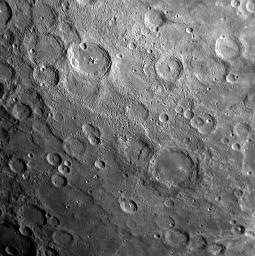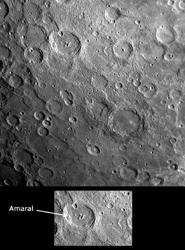
|
Amaral’s Color Palette
- Click the image above for a larger view
- Full-Res JPEG (1018 x 1023) (240.7 kB)
- Full-Res TIFF (1018 x 1023) (1.0 MB)
Caption:

Click on the image for larger version
Near the top center of this image is the crater Amaral, recently named for the Brazilian modernist painter Tarsila do Amaral, who lived from 1886 to 1973 (see PIA11762 ). Amaral crater, with its smooth floor, surrounding ejecta, and small secondary craters, appears noticeably younger than the heavily cratered surface around it. Along with a smooth crater floor, Amaral also has a central peak. Bright material on this peak is of particular interest to members of the MESSENGER Science Team, as it appears to have an unusual color in images acquired in the 11 color filters of the Wide Angle Camera (WAC). In this previously released enhanced color image of Mercury (see PIA11219 ), the central peak of Amaral (just below center left) appears as a bright blue color in striking contrast to the otherwise orange tones of surface material nearby. The different color of the central peak likely indicates rocks with different chemical composition from those on the neighboring surface.
Date Acquired:
January 14, 2008
Image Mission Elapsed Time (MET):
108829116
Instrument:
Narrow Angle Camera (NAC) of the Mercury Dual Imaging System (MDIS)
Resolution:
600 meters/pixel (0.37 miles/pixel)
Scale:
Amaral crater has a diameter of 106 kilometers (66 miles)
Spacecraft Altitude:
24,100 kilometers (15,000 miles)
Background Info:
These images are from MESSENGER, a NASA Discovery mission to conduct the first orbital study of the innermost planet, Mercury. For information regarding the use of images, see the MESSENGER image use policy .
Cataloging Keywords:
| Name | Value | Additional Values |
|---|---|---|
| Target | Mercury | |
| System | ||
| Target Type | Planet | |
| Mission | MESSENGER | |
| Instrument Host | MESSENGER | |
| Host Type | Orbiter | |
| Instrument | Mercury Dual Imaging System (MDIS) | |
| Detector | Narrow Angle Camera (NAC), Wide Angle Camera (WAC) | |
| Extra Keywords | Crater, Grayscale | |
| Acquisition Date | ||
| Release Date | 2009-01-05 | |
| Date in Caption | 2008-01-14 | |
| Image Credit | NASA/Johns Hopkins University Applied Physics Laboratory/Carnegie Institution of Washington | |
| Source | photojournal.jpl.nasa.gov/catalog/PIA11771 | |
| Identifier | PIA11771 | |
